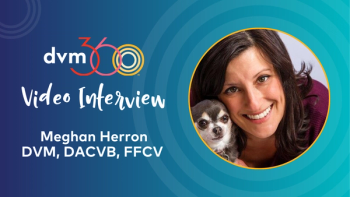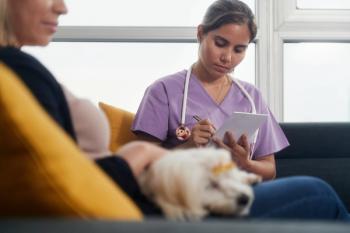
Behavior as part of history collection and physical examination (Proceedings)
Most avian practitioners and many owners understand the importance of yearly physical examination for disease prevention and care of the physical health of the bird.
Most avian practitioners and many owners understand the importance of yearly physical examination for disease prevention and care of the physical health of the bird. More and more significance is now given to the importance of the bird's psychologic health as well. The yearly examination is the ideal opportunity to address behavioral concerns.
According to statistics from the Gabriel Foundation, a nationally recognized parrot rescue organization, birds are frequently relinquished for a variety of reasons. The most commonly relinquished bird is the cockatiel, and the most common reasons cited by owners for abandonment are "note enough time for the bird, and/or "change in priority." Other birds are primarily abandoned for so called "behavioral" reasons, in particular, blue and gold macaws and larger cockatoos.1 When owners relinquish their birds, this often represents a certain degree of disappointment for the owner, a potentially stressful disruption for the bird, and a loss of clientele and income for the avian veterinarian.
According to practice management experts, in the well-run practice, the veterinary technician or assistant assumes the duty of patient intake and the initial gathering of signalment and history. This requires specific training, especially in the area of the behavioral history. Specific behavioral query training, client education handouts, and pre-printed questionnaires can be beneficial. Suggested questions to begin the behavioral history are presented in table 1.
Identification of problem behavioral areas is the first step towards resolution. Once a problem area is identified, the behavioral history continues. For example, if the owner indicates the bird screams when she leaves the room, the next logical questions may include: Is this a new behavior? Does it happen every time you leave the room? What do you do when the bird screams after you leave the room? If the response to the last question is that the owner immediately comes back to the room to reassure the bird, the first steps towards identification of a "cause and effect" or positively-reinforced undesired behavior has begun.2,3
The initial behavioral history, follow up history, behavioral diagnosis and formulation of a behavioral "treatment" plan take time, and in some cases requires regular follow up and reinforcement. In many cases, this is impossible to accomplish within the time allotted for a standard avian wellness examination. In some cases of multiple or severe behavioral problems, it is extremely useful to schedule a separate behavioral consult, often with all members of the interacting human family present. This allows the practitioner time to formulate an initial diagnosis based on the behavioral history, and a tentative treatment plan. In many cases, consultation with other family members provides additional insight not provided from the single owner's view. For example, owner A insists the bird "hates" owner B and will bite. Owner B, however, reveals she is able to handle the bird without problem when owner A is not present.
Since many behavioral problems in birds are linked to inappropriate bonding and inadequate socialization, behavioral treatment frequently involved cooperation from all members of the human "flock". Teaching and demonstrating skills that will be used to attempt to resolve the behavioral problem is much easier with participating members all present.
Clients should be sent home with written behavioral "homework" with clearly defined exercises and goals, including instructions for how to regularly report progress. Poor owner compliance is not uncommon, and practitioners should consider a call back system to track owner progress.
It should be noted that the behavioral history should be a part of every avian examination, not just for patients presenting for a first time visit. Many well-established, long-term patients develop undesirable behaviors during the time between veterinary visits. It is important not to rely on the client to address behavioral concerns, as theses are often forgotten during the excitement of the examination process. Many clients also fail to mention behavioral problems because they don't recognize them as such, and suffer in silence, e.g. "Yes, my bird bites me a lot but I thought that was normal for birds."
Reproductive Behavior
In captive parrots, signs of reproductive behavior can be subtle to chronic oviposition and all degrees in between. Some parrots have been known to produce eggs or present with reproductive-related disease without prior warning or indication of reproductive activity. Reproductive triggers in captivity have corollaries to those in the wild: increasing photoperiod (spring), presence of a potential mate in the form of a mirror, toy or human owner, and presence of nesting material or nest in the form of "bird huts", nest boxes, and paper or other substrate that can be used as nesting material. In some cases the "nest" and "mate" may not be clearly identified or appear to be more than one object or person.
Some birds never demonstrate sexual behavior despite inadvertent intense stimulation on the part of the owner, while some produce egg after egg with no apparent stimulation.
Signs of reproductive behavior occasionally noted by owners include increased territorial behavior (defending perceived nest sites), increase aggression (defending perceived mate), nesting behavior, paper shredding, and signs suggesting pair bonding, including courtship regurgitation, increased preening and masturbation (table 1).
Table 1
A few generalizations can be made based on clinical experience:
- Many larger parrots will pair bond with owners, display overt sexual behavior, but few will actually produce an egg.
- Among larger parrots, cockatoos and macaws appear most prone to pair bonding with owners.
- Species most prone to chronic egg production are cockatiels, lovebirds and budgerigars.
- These smaller birds appear to have a lower threshold to trigger the reproductive cycle, and will often produce eggs despite the owner's attempts to eliminate external triggers.
Table 2
References:
1. The Gabriel Foundation®
2. Weiss Murad J. Becoming a birdbrain: How to solve common avian behavior problems. Proc Assoc Av Vet 123-129. 2001
3. Friedman S, Edling T, Cheney C. Concepts in Behavior: Section 1. In: Harrison G, Lightfoot T. Clinical Avian Medicine. 46-59. 2005.
Reprinted with permission from the North American Veterinary Conference, 2007.
Newsletter
From exam room tips to practice management insights, get trusted veterinary news delivered straight to your inbox—subscribe to dvm360.






